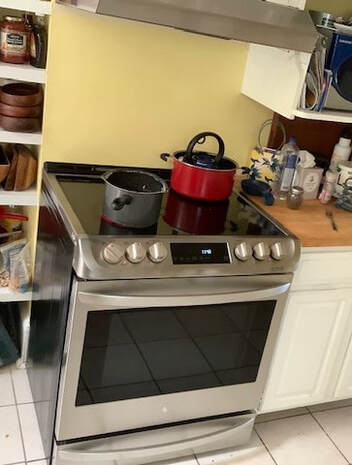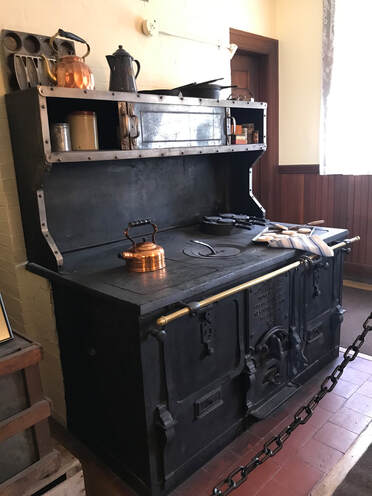 Rice heating on new electric stove. Gas, get over it.
Rice heating on new electric stove. Gas, get over it. Our old gas stove, here when we bought our old house, had become a clunker. She was dirty, stained beyond cleaning. The oven heated unevenly and leaked carbon monoxide to unhealthy levels, 18 ppm, when activated. The cooktop flames worked fine, but were powered by a fossil fuel, natural gas, that contributes to climate change. And, regrettably, more than once we'd left a nearly invisible flame burning after dinner was done.
So recently we said sayonara, baby to Old Bessie and bought a new stove, an electric from LG, which will be powered sustainably by the solar rig on our roof. Unlike the electric models of yesteryear with glowing coils for burners, upon which our moms unceremoniously slammed down their ten-ton iron pressure cookers, this one has a flat, glass stovetop with heating elements beneath. The oven features a newfangled convection option, superior for baking.
Yes, I know, gas flames are easy to modulate on a stovetop, but it's hasn't been hard to figure out -- relearn, really, as I grew up with an electric stove -- how to boil water and sauté veggies with electricity. It's nice, too, that the controls, some digital and some good-old-fashioned knobs, are all up front. Hence, there's no need to reach across hot pans to make oven adjustments.
She's pretty stylish, don't you think, in a brushed-steel kind of way.
So recently we said sayonara, baby to Old Bessie and bought a new stove, an electric from LG, which will be powered sustainably by the solar rig on our roof. Unlike the electric models of yesteryear with glowing coils for burners, upon which our moms unceremoniously slammed down their ten-ton iron pressure cookers, this one has a flat, glass stovetop with heating elements beneath. The oven features a newfangled convection option, superior for baking.
Yes, I know, gas flames are easy to modulate on a stovetop, but it's hasn't been hard to figure out -- relearn, really, as I grew up with an electric stove -- how to boil water and sauté veggies with electricity. It's nice, too, that the controls, some digital and some good-old-fashioned knobs, are all up front. Hence, there's no need to reach across hot pans to make oven adjustments.
She's pretty stylish, don't you think, in a brushed-steel kind of way.
 Not imported from China
Not imported from China Now, you may be wondering: what energy source does America use to cook its flapjacks? I figured it was mostly natural gas these days, but DailyEnergyInsider asserts that almost two-thirds of households get cooking with electricity. In the Northeast, about half of households contain electric stoves. As of 2019, only one percent of stoves in the U.S. feature the latest cooking innovation, the induction stovetop (powered by electricity). That's because, perhaps, most people can't bring themselves to fry up their bacon with electromagnetism. Let the microwave do that weird-science thing behind its closed door.
Regardless, that's still tens of millions of polluting gas stoves that gotta go. Without rapid electrification of stoves and other major household appliances -- clothes dryers, water heaters, outdoor grills -- it's hard to imagine the U.S. achieving the ambitious climate-change goals proposed by the Biden Administration.
Time was, of course, when stoves were powered by firewood. Last month my wife and I took a trip to southern Vermont and made our way to Hildene, the mansion built in 1905 by Abe Lincoln's only child to live into adulthood, Robert Todd Lincoln. As president of the Pullman Car Company, at one point the largest manufacturer in the world, Lincoln could afford the most "modern" appliances. Everything's relative, I suppose, but it must have been tricky regulating temperatures in the wood-fired behemoth that dominated his butler's pantry. Once you stoked that baby with a couple of split hickory logs, there was no going back.
Burnt flapjacks, anyone?
Regardless, that's still tens of millions of polluting gas stoves that gotta go. Without rapid electrification of stoves and other major household appliances -- clothes dryers, water heaters, outdoor grills -- it's hard to imagine the U.S. achieving the ambitious climate-change goals proposed by the Biden Administration.
Time was, of course, when stoves were powered by firewood. Last month my wife and I took a trip to southern Vermont and made our way to Hildene, the mansion built in 1905 by Abe Lincoln's only child to live into adulthood, Robert Todd Lincoln. As president of the Pullman Car Company, at one point the largest manufacturer in the world, Lincoln could afford the most "modern" appliances. Everything's relative, I suppose, but it must have been tricky regulating temperatures in the wood-fired behemoth that dominated his butler's pantry. Once you stoked that baby with a couple of split hickory logs, there was no going back.
Burnt flapjacks, anyone?
 RSS Feed
RSS Feed